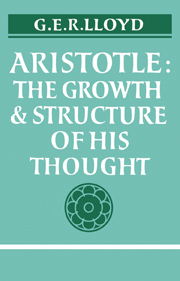Preface
Published online by Cambridge University Press: 06 July 2010
Summary
This book is intended to help the student to discover and explore Aristotle. Most people would agree that he is not an easy philosopher to approach. His treatises cannot be read for enjoyment purely as literature, as many of Plato's dialogues can, and the man behind the treatises has the reputation of being a dry, uninspiring, even rather inhuman, person. If in the popular view Plato is as much a poet as a philosopher, Aristotle is still generally thought of first and foremost as a dogmatist and systematiser. This account of him, which is largely the product of a tendency to confuse Aristotle with Aristotelianism, is grossly exaggerated. Like Plato, he conceived the business of philosophy to consist as much in the defining of problems, the examining of alternative views, and the exploring of difficulties, as in the propounding of solutions, and his thought, like Plato's again, underwent a gradual evolution, even though this is, in his case, much more difficult to reconstruct owing to the nature of our evidence.
But while Aristotle is neither as unimaginative nor as inflexible as he is sometimes represented, no one can deny that his thought is often opaque. The treatises make slow and difficult reading, although their difficulty arises as much from the complexity and subtlety of their ideas as from the obscurity of Aristotle's expression. Yet however daunting the texts appear, there is no substitute for a close study of Aristotle's own words to grasp his philosophy.
- Type
- Chapter
- Information
- AristotleThe Growth and Structure of his Thought, pp. ix - xiiPublisher: Cambridge University PressPrint publication year: 1968



